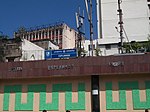Esplanade Mansions, Kolkata
1910 establishments in IndiaArt Nouveau architecture in IndiaBuildings and structures completed in 1910Buildings and structures in KolkataTourist attractions in Kolkata ... and 1 more
Use Indian English from September 2020

The Esplanade Mansions is a heritage building located in the Indian city of Kolkata, on the Esplanade Row and Marx Engels Beethi Road crossing, opposite to the Raj Bhavan. It was one of the buildings owned by Jewish businessman David Elias Ezra. The residential building was built in the Art Nouveau architecture style. Today it is owned by Life Insurance Corporation and houses commercial, railways and other government offices.
Excerpt from the Wikipedia article Esplanade Mansions, Kolkata (License: CC BY-SA 3.0, Authors, Images).Esplanade Mansions, Kolkata
Old Court House Street, Kolkata B. B. D. Bagh (Kolkata)
Geographical coordinates (GPS) Address External links Nearby Places Show on map
Geographical coordinates (GPS)
| Latitude | Longitude |
|---|---|
| N 22.566388888889 ° | E 88.348888888889 ° |
Address
Esplanade Mansions
Old Court House Street
700062 Kolkata, B. B. D. Bagh (Kolkata)
West Bengal, India
Open on Google Maps








